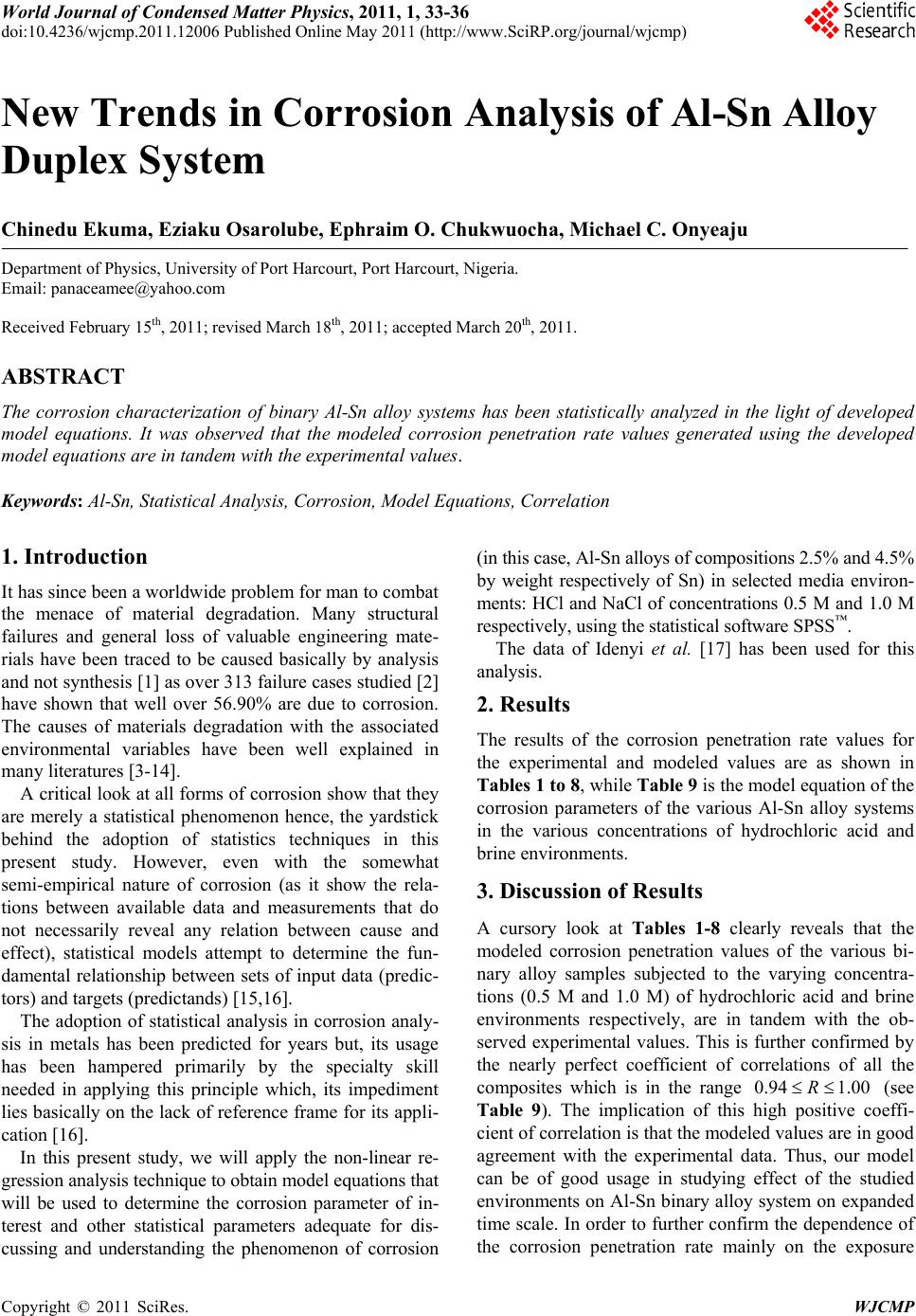
World Journal of Condensed Matter Physics, 2011, 1, 33-36
doi:10.4236/wjcmp.2011.12006 Published Online May 2011 (http://www.SciRP.org/journal/wjcmp)
Copyright © 2011 SciRes. WJCMP
New Trends in Corrosion Analysis of Al-Sn Alloy
Duplex System
Chinedu Ekuma, Eziaku Osarolube, Ephraim O. Chukwuocha, Michael C. Onyeaju
Department of Physics, University of Port Harcourt, Port Harcourt, Nigeria.
Email: panaceamee@yahoo.com
Received February 15th, 2011; revised March 18th, 2011; accepted March 20th, 2011.
ABSTRACT
The corrosion characterization of binary Al-Sn alloy systems has been statistically analyzed in the light of developed
model equations. It was observed that the modeled corrosion penetration rate values generated using the developed
model equations are in tandem with the experimental values.
Keywords: Al-Sn, Statistical Analysis, Corrosion, Model Equations, Correlation
1. Introduction
It has since been a worldwide problem for man to combat
the menace of material degradation. Many structural
failures and general loss of valuable engineering mate-
rials have been traced to be caused basically by analysis
and not synthesis [1] as over 313 failure cases studied [2]
have shown that well over 56.90% are due to corrosion.
The causes of materials degradation with the associated
environmental variables have been well explained in
many literatures [3-14].
A critical look at all forms of co rrosion show that th ey
are merely a statistical phenomenon hence, the yardstick
behind the adoption of statistics techniques in this
present study. However, even with the somewhat
semi-empirical nature of corrosion (as it show the rela-
tions between available data and measurements that do
not necessarily reveal any relation between cause and
effect), statistical models attempt to determine the fun-
damental relationship between sets of input data (predic-
tors) and targets (predictands) [15,16].
The adoption of statistical analysis in corrosion analy-
sis in metals has been predicted for years but, its usage
has been hampered primarily by the specialty skill
needed in applying this principle which, its impediment
lies basically on the lack of reference frame for its appli-
cation [16] .
In this present study, we will apply the non-linear re-
gression analysis technique to obtain model equations that
will be used to determine the corrosion parameter of in-
terest and other statistical parameters adequate for dis-
cussing and understanding the phenomenon of corrosion
(in this case, Al-Sn alloys of compositions 2.5% and 4.5%
by weight respectively of Sn) in selected media environ-
ments: HCl and NaCl of concentrations 0.5 M and 1.0 M
respectively, using the statistical software SPSS™.
The data of Idenyi et al. [17] has been used for this
analysis.
2. Results
The results of the corrosion penetration rate values for
the experimental and modeled values are as shown in
Tables 1 to 8, while Table 9 is the model equation of the
corrosion parameters of the various Al-Sn alloy systems
in the various concentrations of hydrochloric acid and
brine environments.
3. Discussion of Results
A cursory look at Tables 1-8 clearly reveals that the
modeled corrosion penetration values of the various bi-
nary alloy samples subjected to the varying concentra-
tions (0.5 M and 1.0 M) of hydrochloric acid and brine
environments respectively, are in tandem with the ob-
served experimental values. This is further confirmed by
the nearly perfect coefficient of correlations of all the
composites which is in the range
(see
Table 9). The implication of this high positive coeffi-
cient of correlation is that the modeled values are in good
agreement with the experimental data. Thus, our model
can be of good usage in studying effect of the studied
environments on Al-Sn binary alloy system on expanded
time scale. In order to further confirm the dependence of
the corrosion penetration rate mainly on the exposure